Enterprise tech stack & governance for multi-location SEO
Learn how to build a scalable tech stack and governance model to streamline SEO across multiple locations, boost visibility, and ensure brand consistency.
You’re managing hundreds of locations, trying to win local search in local markets because 46% of all Google searches have local intent. But it’s chaotic.
One day, you’re trying to fix outdated information in Google Business Profiles (GBPs). Next, you’re checking if your store addresses are correct. But this isn’t going as smoothly as you’d hope.
Why?
Because what works easily for one location rarely works at scale. But with the right tools, you can turn multi-location SEO (MLS) from a manual grind into a high-impact growth engine.
In this guide, we’ll show how you can streamline local SEO for multiple locations to improve visibility and build brand trust at scale.
Enterprise SEO tech stack & governance for multi-location SEO
An SEO tech stack is a set of tools that helps you scale SEO across multiple locations. A good stack does two things:
- Automates repetitive work, like updating GBPs
- Gives you insights at the location level, so you can see what’s working (and where).
You can build your stack in one of two ways:
- Use an all-in-one SEO suite that handles keyword tracking, local pages creation, schema markup, and GBP management
- Use a mix of specialized tools for different use cases
Let’s say you’re managing SEO for Zerox Shoe Co., an international footwear retailer with 350 store locations. In this case, you could use:
- Semrush to track keyword visibility, performance by region, and bulk update GBP listings
- RankMath plugin to leverage schema markup at scale
- SEOmatic to automate landing page creation
Pro tip: Build a comprehensive local SEO tool stack that can manage every aspect of local SEO, even across multiple locations. So you don’t have to waste time switching between various tools.
Governance: The second half that completes the stack
But tools are only half the setup. Without governance (shared rules and workflows), your enterprise SEO system is incomplete. So, make sure you also have:
- Templates for location pages so that every page follows the same proven structure
- Content guidelines to maintain consistency in overall tone and branding
- Approval workflows for updates to GBP listings or website content
- Role-based access control to limit who can make changes, and where
- Audit schedules to catch inconsistencies before they reduce rankings
Once these elements are set up, you can manage hundreds of location pages with the same level of accuracy and quality as your first ten. Location-specific page updates, business hour changes, seasonal promotions, and GBP edits can all be rolled out quickly because everyone on your team will follow the same workflow.
One enterprise that does this exceptionally well is Marriott International. They handle local SEO across 9,361 global properties (as of 2024). Each hotel’s GBP is fully optimized with accurate amenities and location-specific services.
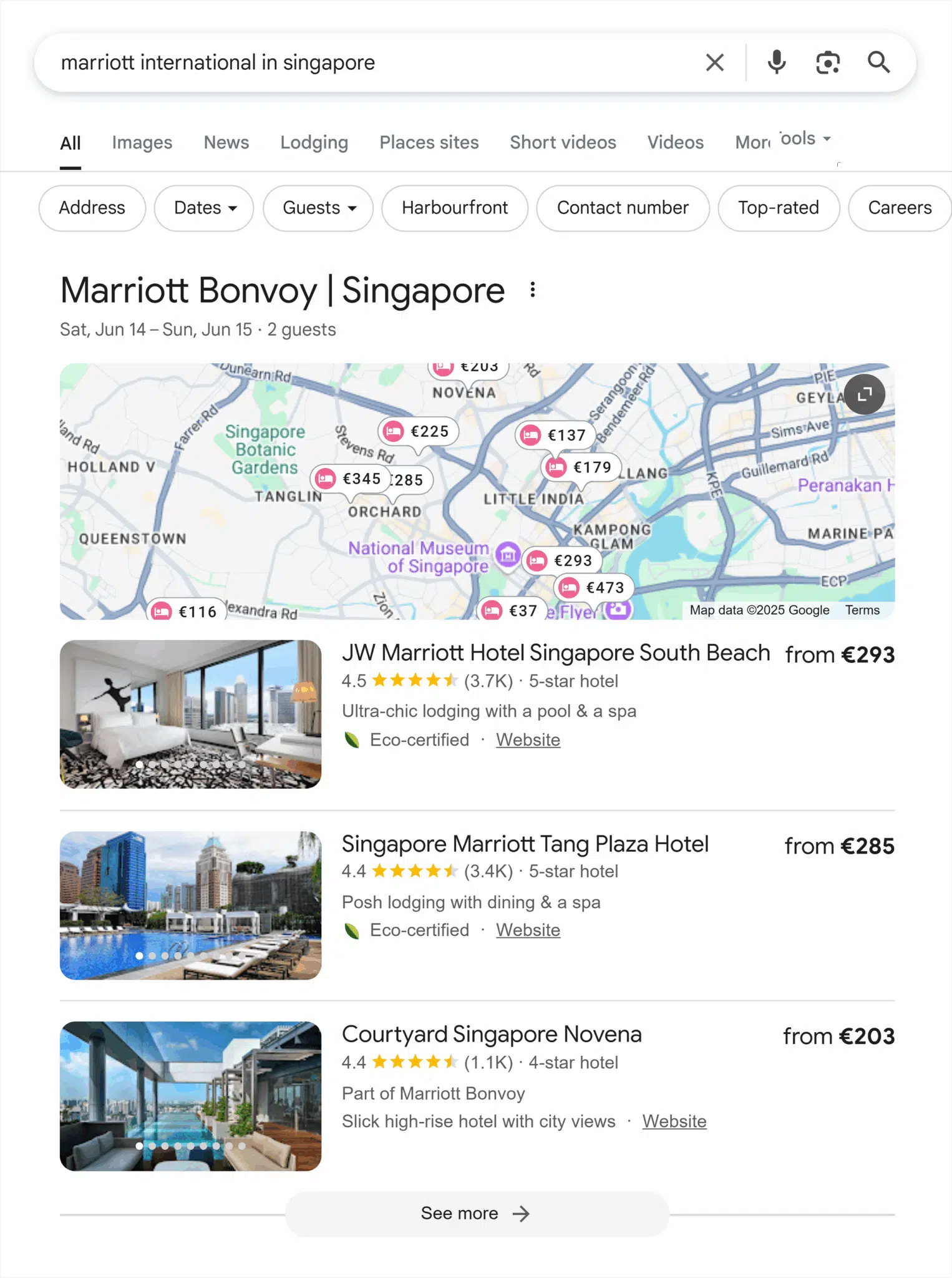
Their location pages include nearby landmarks and hyperlocal keywords tailored to traveler intent. But, the overall layout and branding stay consistent across all locations. Here’s how:

The image at the top shows the Algiers Marriott Hotel Bab Ezzouar in Algeria, and below is the Cairo Marriott Hotel based in Egypt.
Both locations are different, but notice how each page uses standard fonts, colors, logo placement, and booking interface. No matter which hotel you view, it feels unmistakably like a Marriott experience. That’s consistency!
Role of automation and platforms in scaling multi-location SEO
Automation helps stay consistent at scale. How? Speed and efficiency. All of the processes are coded on the backend, which reduces the chance of human errors and speeds up task execution.
Smaller businesses may manage local SEO manually with spreadsheets to track business hours, listings, promotions, or review responses. That approach might work fine if you’re handling three to five locations.
But, for enterprise teams that manage hundreds of locations, manual methods quickly become unmanageable. Why? Because you may miss small changes, like updating new business hours for different locations.
Even if you’re an incredibly organized type of person, applying updates manually wastes time. And the more tools and tabs you juggle, the higher the chances of making mistakes. After all, we’re humans!
Suppose the SEO team at Zerox Shoe Co. updates store hours for 350 locations in a shared spreadsheet. But, one of their team members forgot to sync those changes with the GBP listings. Now, customers who search for local store hours will see the wrong times.
When they show up and find the store closed, they get frustrated, and many may leave negative reviews. That’s how one minor-seeming oversight (which isn’t actually very minor at all) hurts both your visibility and customer trust.
That’s why 86% of SEO professionals have integrated AI into their workflows. They’re moving away from manual inputs toward systems that scale more easily. And enterprise SEO platforms are what have been making that shift possible.
Let’s look at how.
Wix Dominated ‘How to Start a Blog’ Keyword for 2+ Years Using Semrush
✓ Find high-volume keywords you can actually win
✓ See which content deserves strategic schema markup
✓ Identify quick-win featured snippet opportunities
Free instant insights.
Automate local landing page creation and metadata population
If the Zerox Shoe Co. team manually creates landing pages for their store locations, the process would look like this: a designer duplicates layouts, a copywriter swaps in location-specific info, an SEO tweaks metadata, and someone publishes the page.
Now multiply that across 350 locations. That’s 350 pages to update when your business hours change or a phone number gets corrected.
It’s slow and prone to errors.
So, instead of adopting the manual approach, automate the process. For this, you need three things:
- Structured template (reusable page layout with clearly defined fields to insert location-specific content)
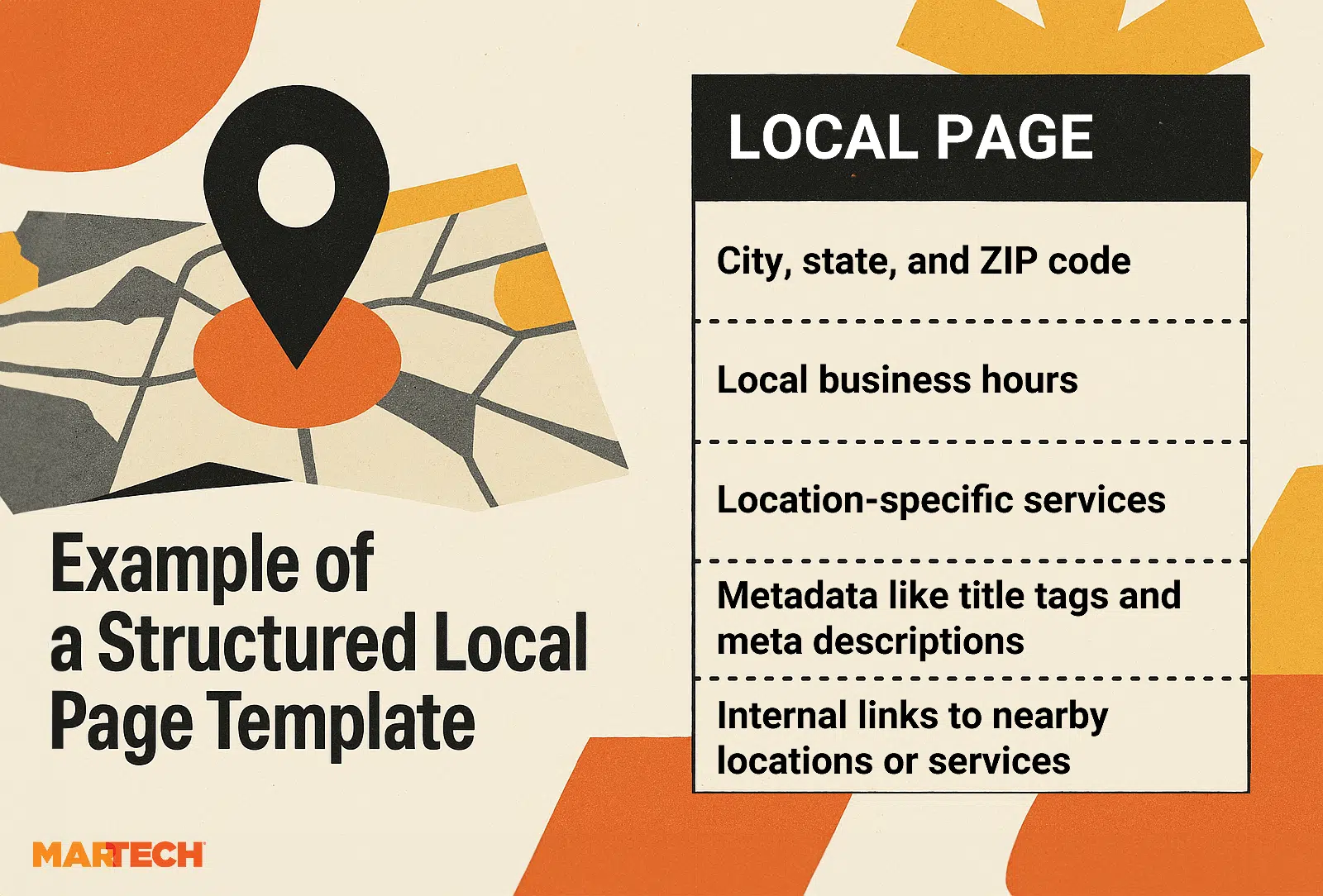
- CMS with all your location data
- An automation tool that integrates the two and builds pages
For automation, you can use landing page builders like Instapage and Unbounce or an SEO tool like Yext or SEOmatic.
For example, if you were to do this using SEOmatic the steps would be:
- First, choose a master template from the built-in templates.
- Then, integrate your CMS with SEOmatic to get location-specific data.
- Next, generate fully built, SEO-optimized pages with localized metadata.
And just like that, you turn a time-intensive task into a seamless one.
Use dynamic location-specific content (via CMS or headless solutions)
Dynamic content adapts based on location-specific data, such as what your local visitors care about, their search behavior, needs, or specific FAQs.
Take, for instance, Booking.com which operates in 70+ countries with 198 offices worldwide. Instead of showing everyone the same homepage, they personalize content based on each user’s specific location. For example, if a user was browsing their site from the US, it would highlight popular destinations for US travelers.
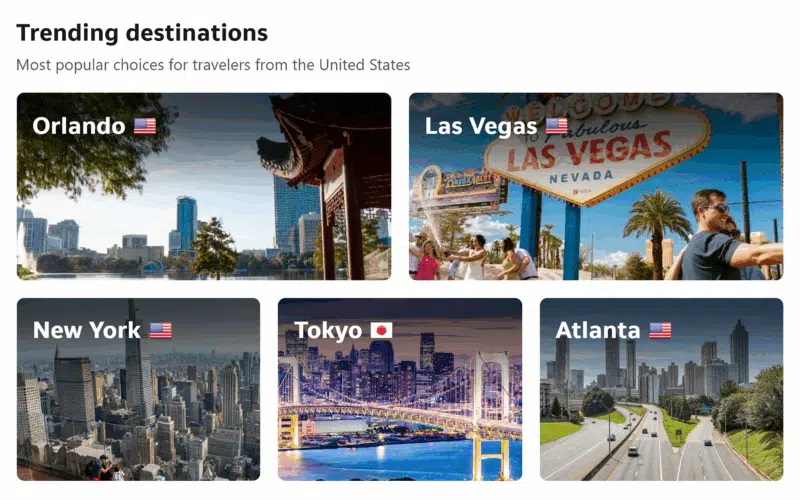
This way, the user feels like the content is made just for them.
But how can you do this at scale?
Use a content management system (CMS) that supports dynamic content modules. There are two main options to do this:
- Use a traditional CMS like WordPress with plugins such as ACF or Elementor.
- Use a headless CMS like Contentful or Sanity. A headless CMS separates content from design, so your developers can reuse modules across hundreds of pages and customize what each one shows based on location data.
Let’s see how you can tailor your content to specific regions using Contentful:
- Go to “Settings” > “Locales” in your Contentful space.
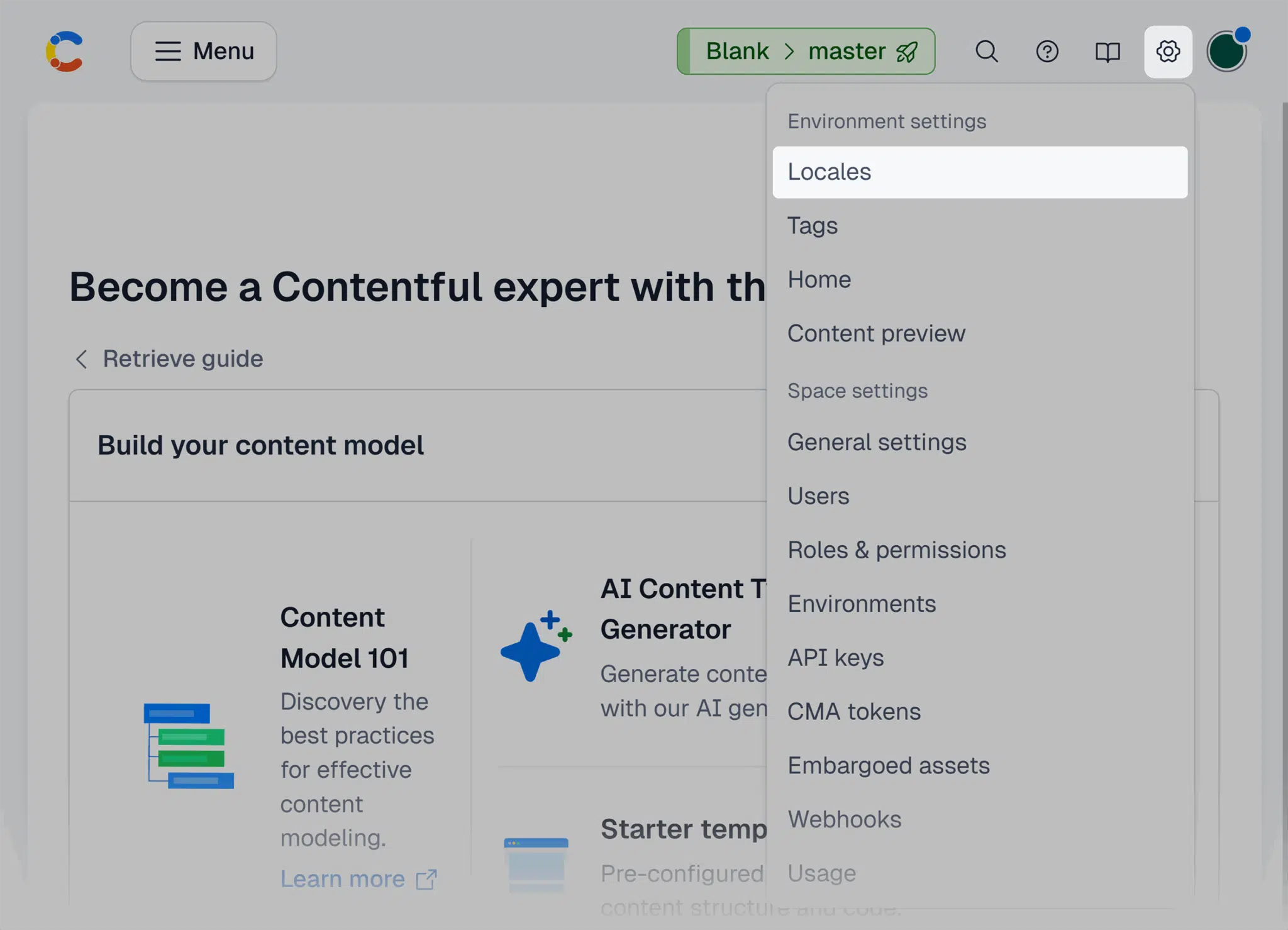
- Click “+ Add locale.”

- Choose a locale of your choice, like en-US, fr-CA, from the dropdown.
- Under “Locale settings,” check:
- Enable this locale in response
- Enable editing for this locale
- (Optional) Allow required fields to be empty
- Click “Save” to finish the setup.
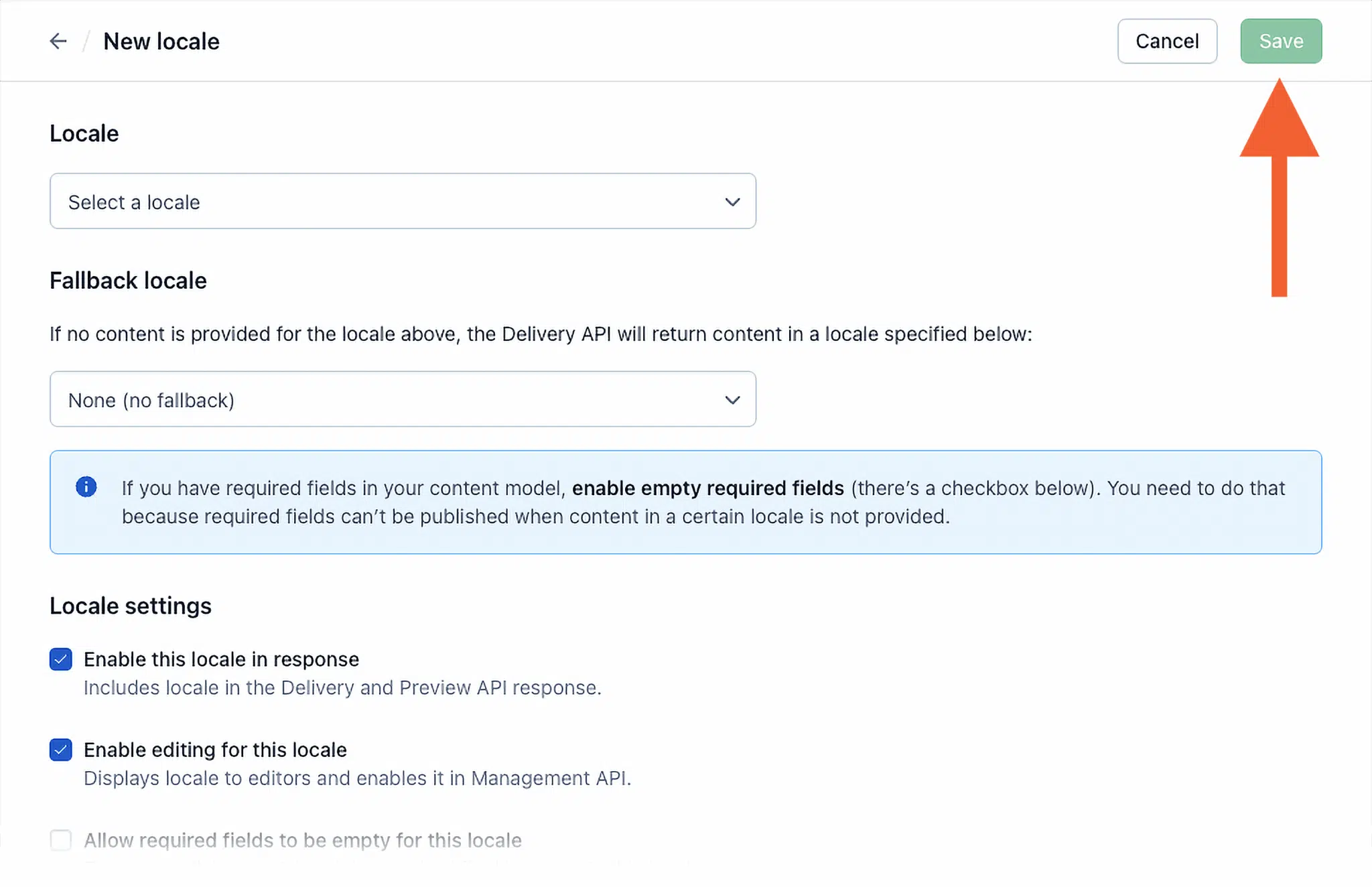
Leverage schema markup at scale for multiple locations
Schema markup, also known as structured data, is a code you add to your web pages to help search engines understand what the content means in a better way. Pages using schema markup see visitors stay up to 1.5x longer than those without it because schema gives Google more context about your content.
There are different types of schemas. But, for multi-location SEO, you should use the LocalBusiness schema. It helps search engines understand and display your key business details like business name, address, phone, and even reviews.
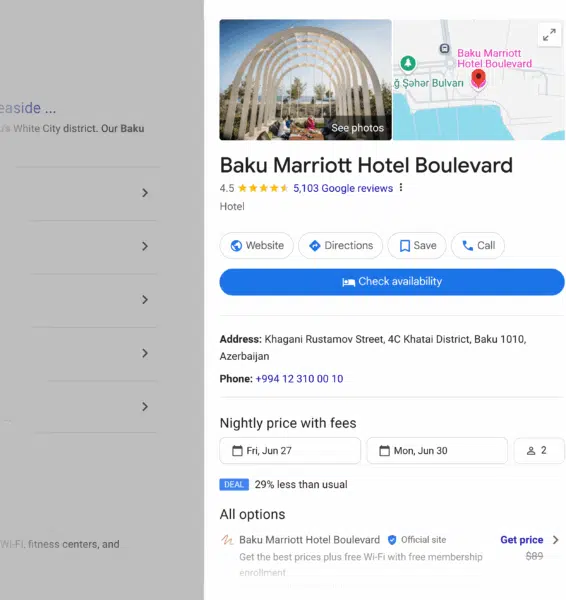
You can use Rank Math Pro, Schema App, or Yoast SEO plugins to add schema markup to multiple location pages.
Let’s see how to do this using the Rank Math Pro plugin:
- Install and activate the Rank Math plugin on your CMS.
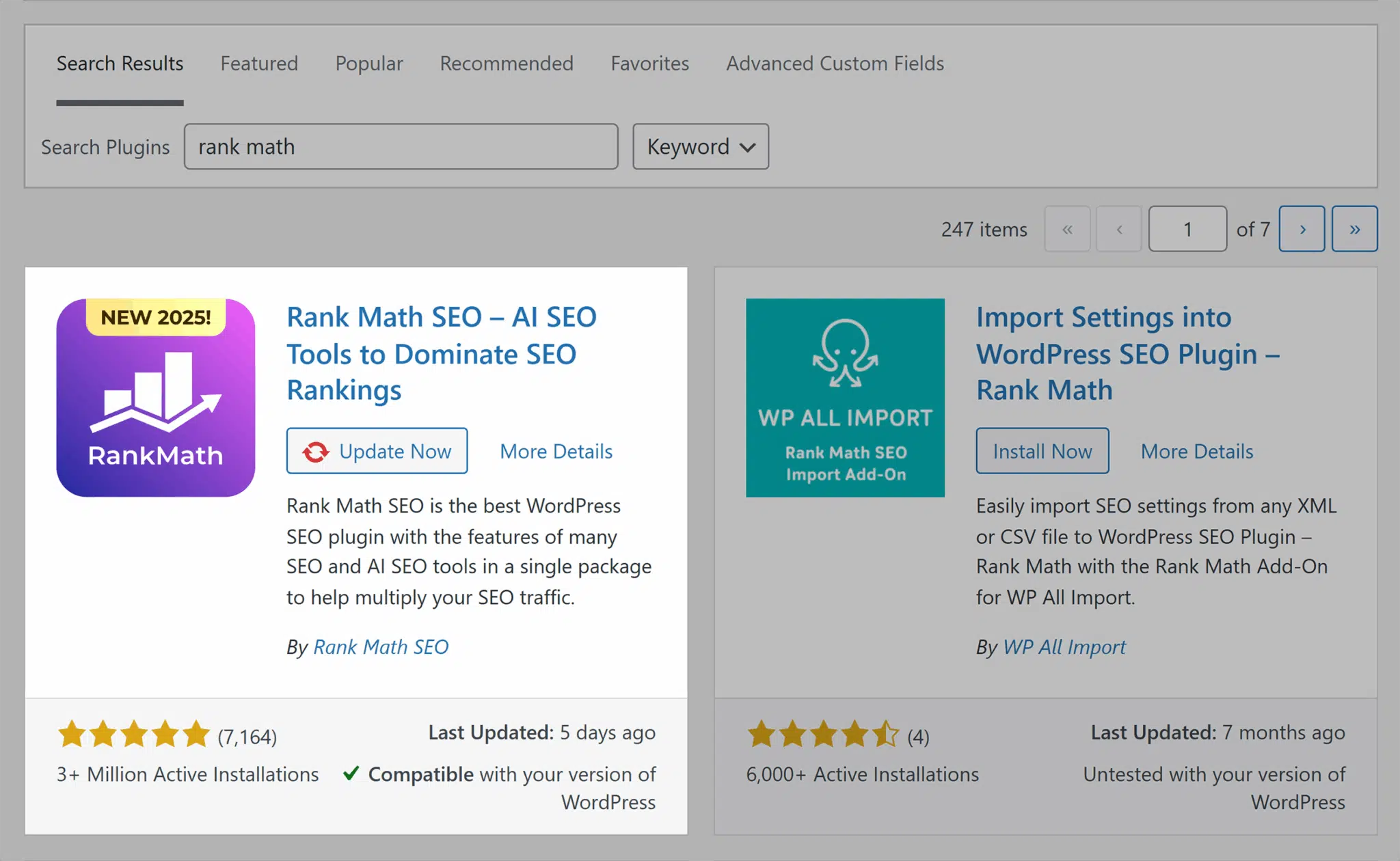
- Go to the Rank Math dashboard and enable “Local SEO.”
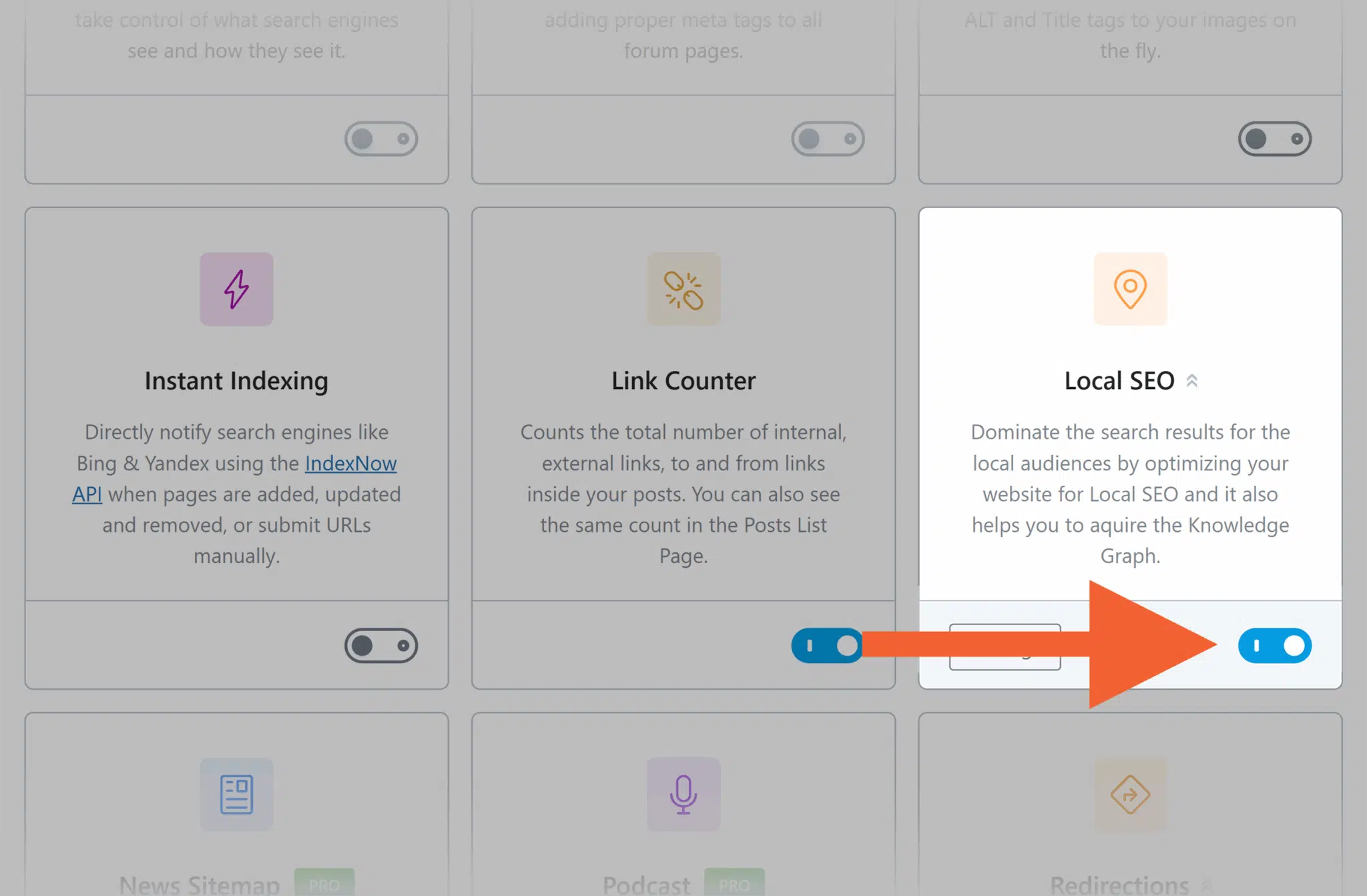
- Then enable the “Schema” module.
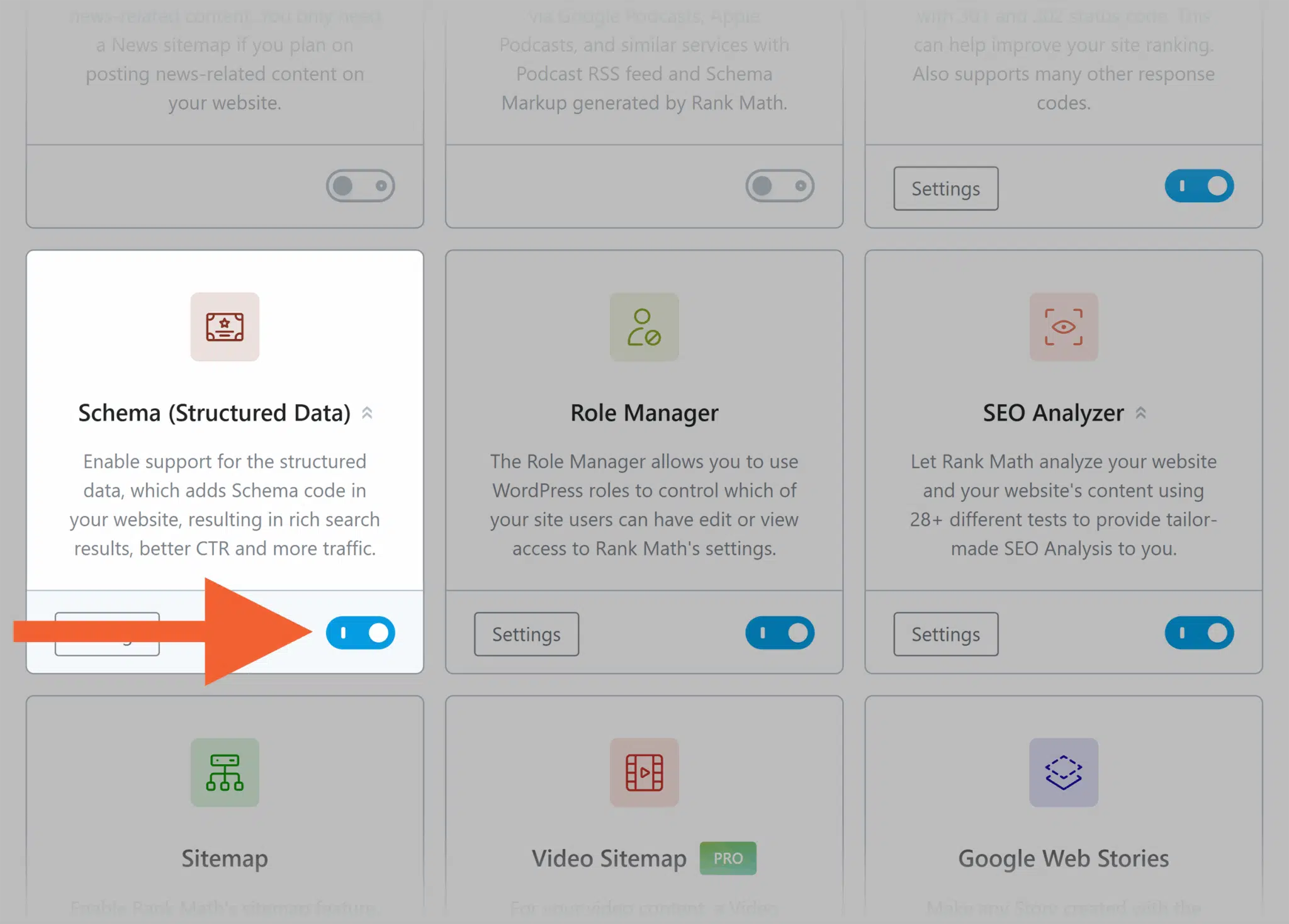
- Go to “Rank Math” > “Titles & Meta” > “Local SEO.”
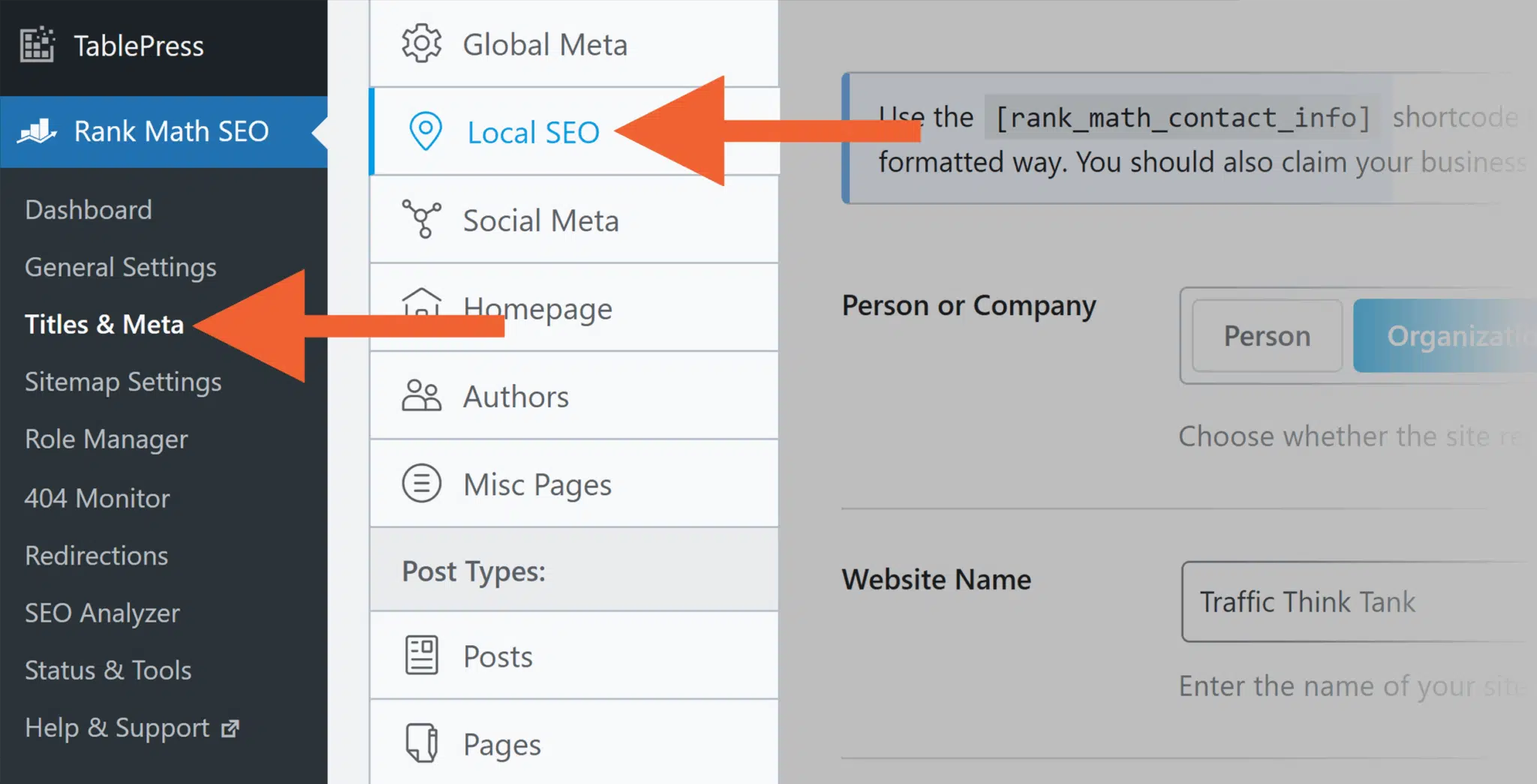
- Scroll down to the bottom of the settings page and turn on “Use Multiple Locations.” This creates the RM Locations custom post type.

- Go to “RM Locations” > “All RM Locations” > “Add New Post.”
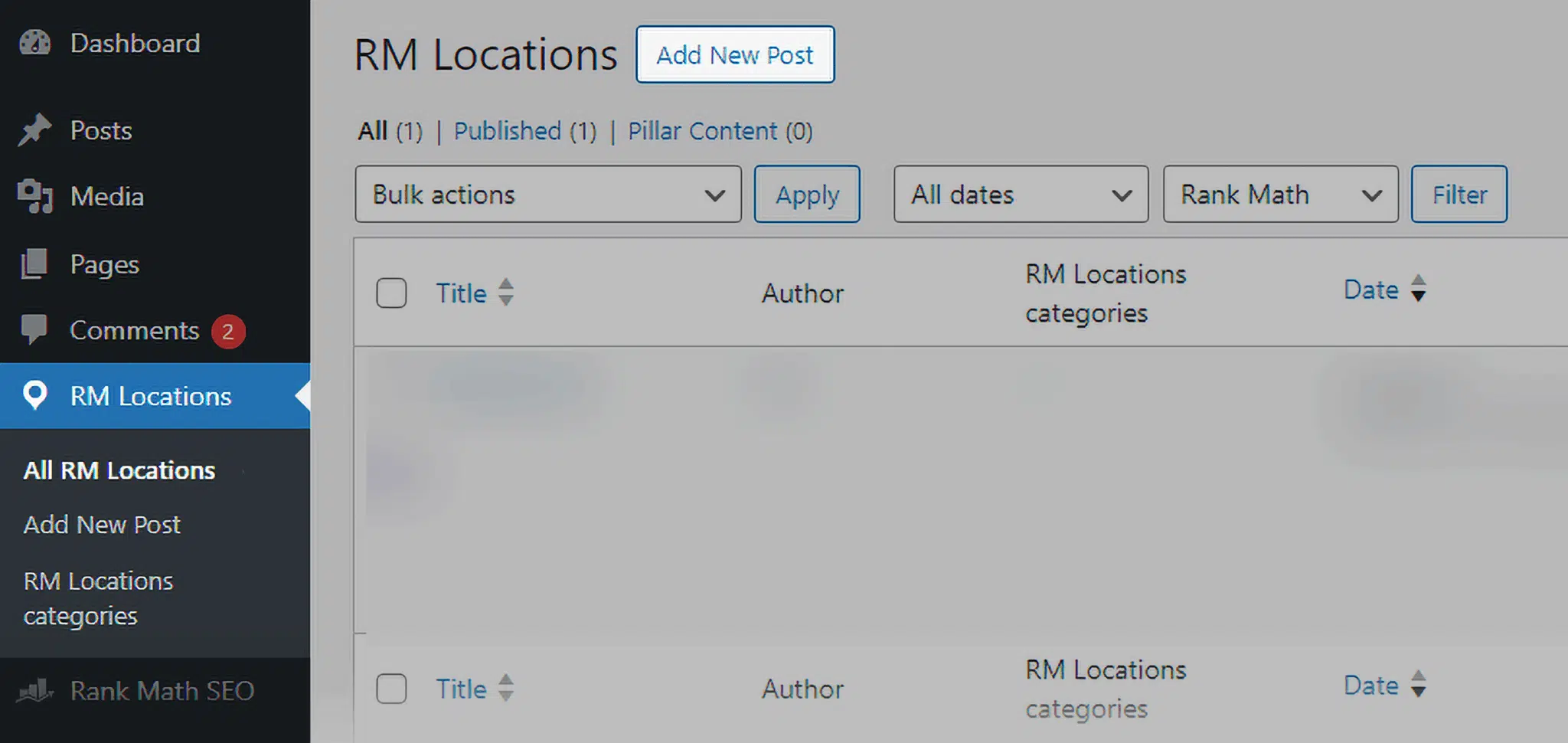
- Head over to the Rank Math metabox and access “Schema” > “Schema Generator.” Here, you can select the “Local Business” schema.

- Now, the “Schema Builder” will be accessible, and you can add all your relevant location details. Once done, click “Save for this Post.”
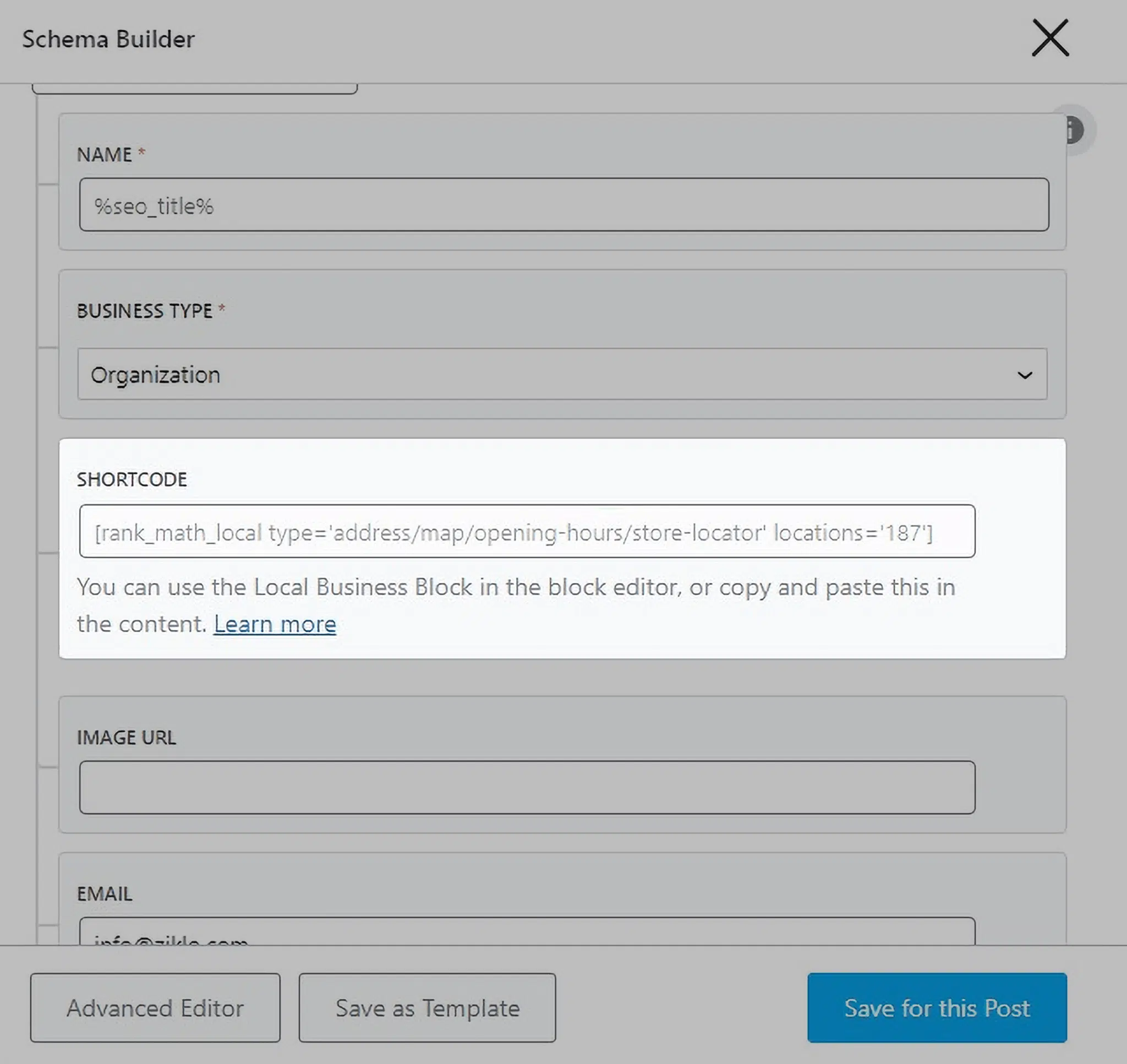
And that’s it, you’ve applied LocalBusiness schema to your locations.
Bulk publish GMB/GBP updates and local citations
Let’s go back to our demo store example. If Zerox Shoe Co. needs to update store hours across 350 locations, doing it manually for each GBP isn’t realistic.
Why?
Because even if you divide the work among team members, it will still consume a lot of time.
Instead, use listings management tools to update all your business profiles and local citations in bulk. Some common options to do this are Semrush, Yext, BrightLocal, and Uberall.
Let’s walk through how you can do it using the Listing Management tool:
- Click on “Listing Management.”
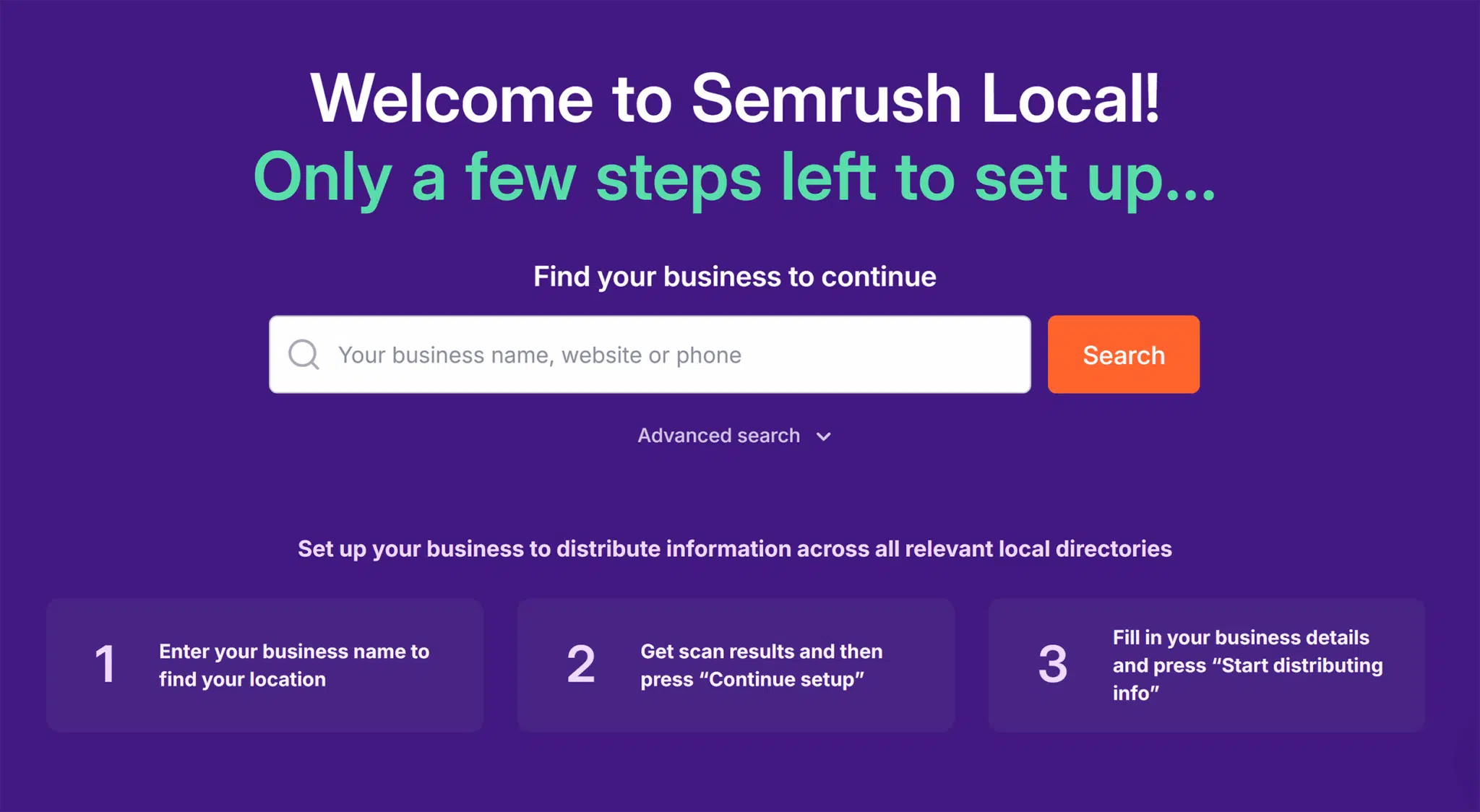
- In the “Locations” tab, enter your business name or zip code in the search bar. You’ll see a summary of each location, including live status and any issues.
- On the right-hand side of the listing card, click the three dots icon to open a drop-down menu.

- In the drop-down, click “Bulk edit.” This lets you update details like business hours, phone numbers, or categories across multiple listings in one go.
- After entering the updates, confirm your changes and push them live.
The tool will automatically sync your data across supported directories, including Google Business Profile, Yelp, Bing, and others.
Dig deeper: Find out which Google Business Profile metrics matter most in multi-location competitive research.
Must-have features for multi-location SEO tools
By now, you’ve seen how you can automate different aspects of your multi-location SEO strategy using various tools. But not every tool supports every feature. So, before we compare tools, here’s an overview of the key features an SEO tool should have to support multi-location SEO at scale:
Automated GBP management: This feature allows you to update all of your GBPs in bulk. You don’t have to log into each profile separately to change store hours, update service areas, or fix contact details. Everything gets pushed live across locations all at once which will keep your listings consistent and save hours of manual work.
Landing page automation: You can use structured templates to generate pages for all your locations, each optimized with the correct metadata, local content, and internal links. It’s a scalable way to build your local presence without hand-coding each page.
Schema markup at scale: With this feature, you can apply LocalBusiness schema to hundreds of location pages, without writing code manually. That means every page is eligible for rich results in Google’s search results like maps, reviews, and open now labels.
Review monitoring: Instead of checking multiple sites for customer feedback, review monitoring pulls reviews from GBP, Yelp, or Facebook into a single dashboard. It gives you a clear view of what people say about your business and makes it easier to respond and manage your brand reputation at scale.
Multi-location reporting & dashboards: These dashboards centralize key performance data such as traffic, visibility, conversions, and profile views. They help you to see which locations are underperforming, where traffic is dropping, or which regions are growing fast, so that you can adjust strategy quickly.
CMS integration: When you connect your CMS to an SEO tool, you can make bulk edits, like updating your multiple GBPs directly from the SEO tool in one go. This reduces the back-and-forth between teams and tools to streamline your workflow.
Now that you know what each feature means, here’s a quick breakdown of which tools support them.
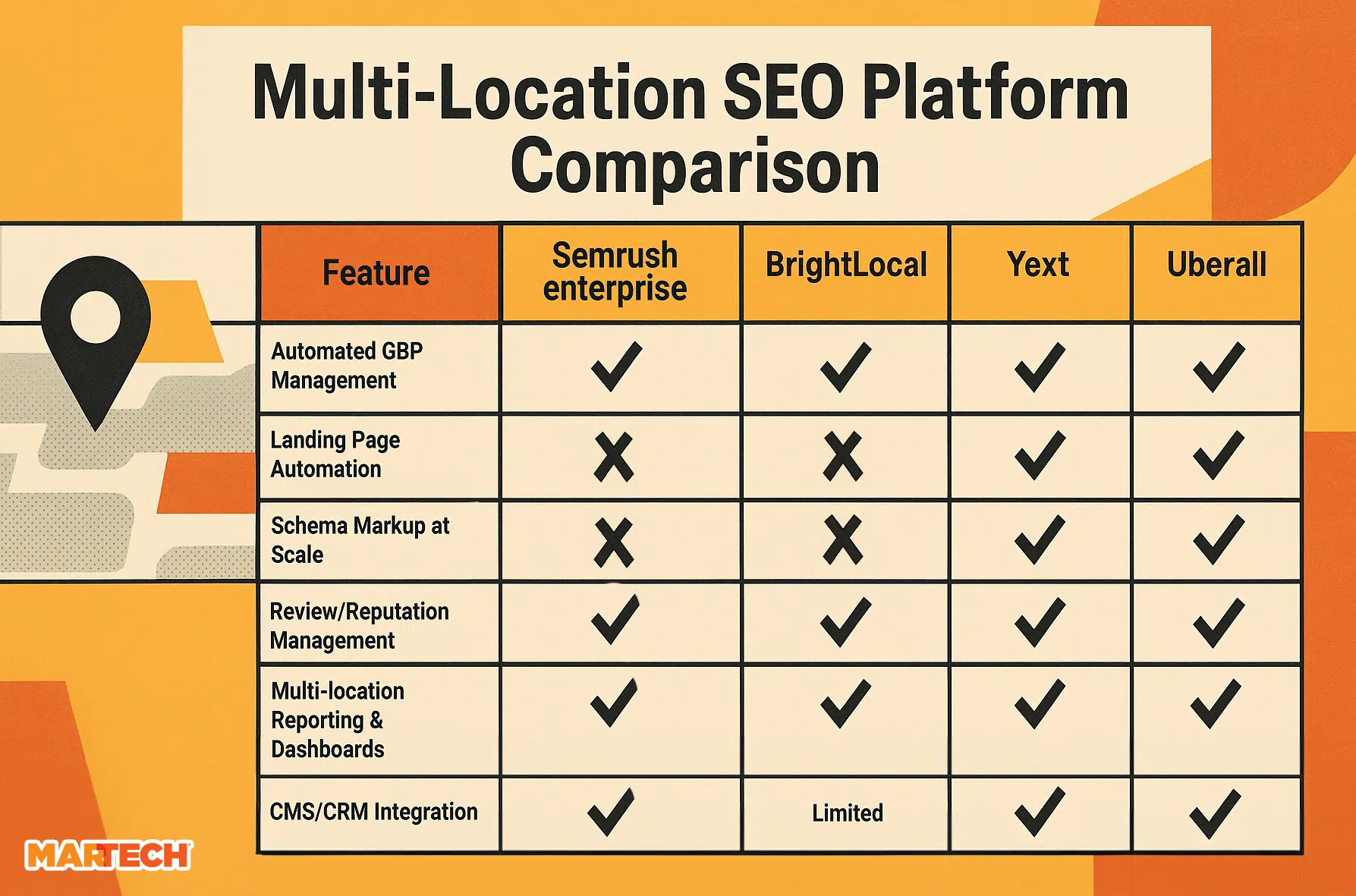
Structure your SEO team
When handling SEO for multiple locations, be clear about what your team structure will be because that will determine how you’ll scale workflows across so many locations.
So let’s explore the three main types of team structures.
Centralized structure
In a centralized model, all SEO strategy and execution happen from one core team, usually at headquarters. This team sets the direction, owns the tools, and handles implementation. Go for this structure if brand consistency and efficiency are your top priorities.
Why?
Because the centralized team controls all messaging and workflows to make sure everything stays aligned and streamlined across locations.
However, they may miss cultural aspects and regional opportunities because decisions are made far from the local context.
For example, the central SEO team at Zerox Shoe Co. might launch a summer sandals campaign across all locations in July. But in Australia, it’s actually winter in July, so that campaign would feel completely out of place to local shoppers.
Decentralized structure
In a decentralized model, SEO is handled by regional or local teams. Each team creates content, runs campaigns, and adapts strategy for their specific market.
This structure works well when your enterprise operates in diverse regions with different languages, cultures, or user behaviors. It gives your local teams the flexibility to stay relevant to location-specific trends.
For example, Zerox’s team in Denmark launches a “Back to School” campaign in August, while their Algerian team delays theirs until September to align with local school calendars. This way, each team tailors the timing and messaging based on what works best for their region.
But decentralization has its challenges, too. Since decision-making is spread across local teams, you may end up with inconsistent quality and messaging across your location pages.
One team might create polished, on-brand content, while another might produce copy that feels off-brand or misaligned with the overall brand tone.
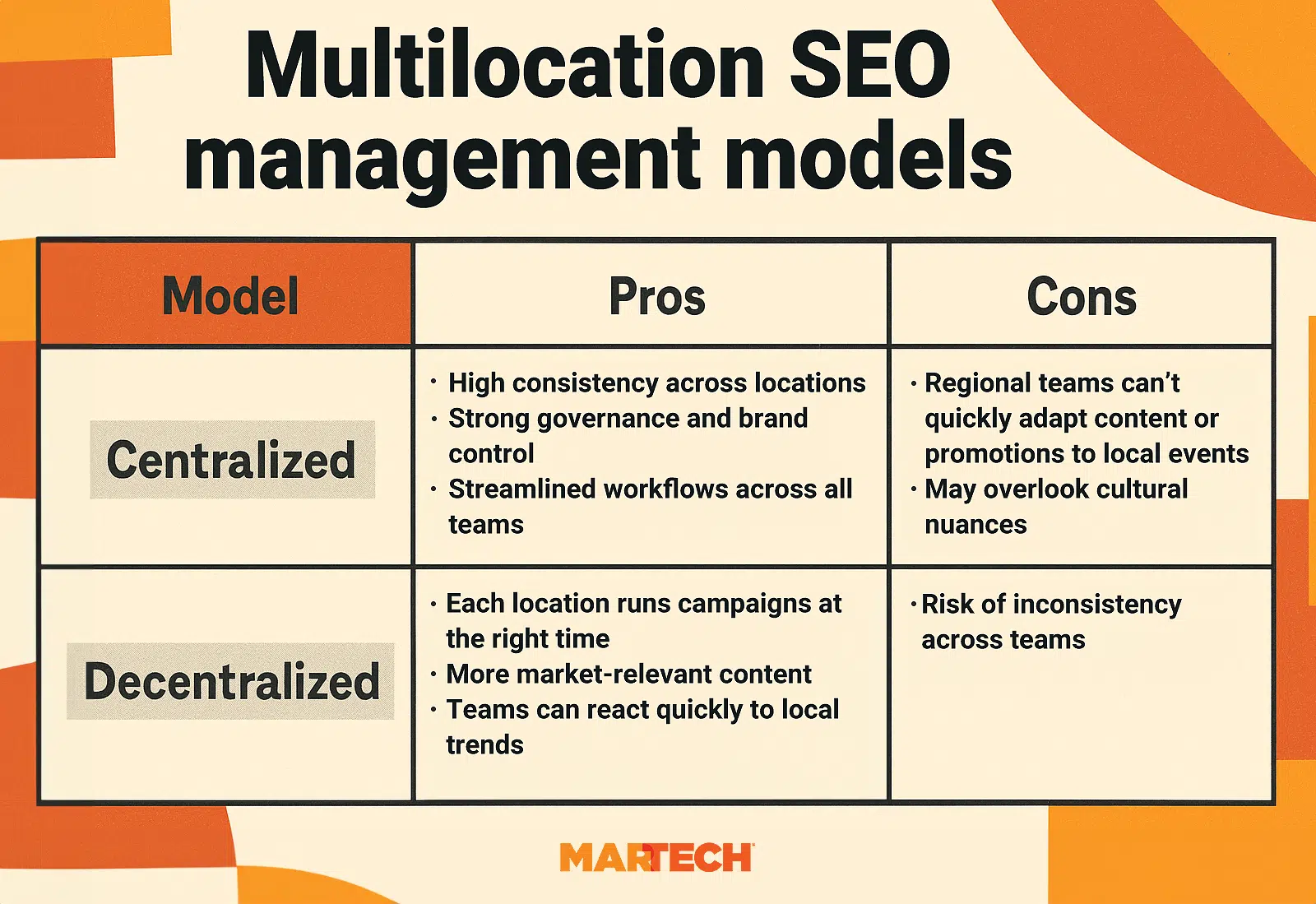
Hybrid structure: Center of Excellence (CoE) model
The hybrid model blends centralized strategy with the flexibility of local execution. This way, enterprises can maintain brand consistency across multiple locations without losing local relevance.
Here’s how it works:
A central SEO team sets the direction by choosing tools, creating templates, and defining policies. Then, regional teams adapt those frameworks to their local markets. They handle execution but within the bounds set by central teams.
Suppose the central team at Zerox Shoe Co. defines the tech stack, builds standardized templates for store pages, and sets up approval workflows.
Regional teams then use dynamic content modules to show location-specific content. But before their updates go live, they’re routed through central teams for review to make sure nothing looks off-brand.
This model works well even when team sizes or experience levels vary. Because the central team provides a solid foundation, regional teams don’t have to start from scratch.
Create an SEO governance policy for consistency and quality
An SEO governance policy is a set of shared rules and quality checks that guide how your enterprise SEO gets done across multiple locations. It prevents even minor inconsistencies such as mismatched business hours and incorrect addresses.
Imagine Zerox Shoe Co. has a store in Boston, but the address listed on their local page is outdated. A customer searching for “shoe store near me” on Google Maps sees the old address, drives to it, and finds an empty building. Not only is that a lost sale, but the customer may leave with a negative perception that makes them never want to come back again.
But if Zerox had a solid SEO governance policy, its teams would follow a clear process for updating location data. This would ensure that all local location details are accurate.
Note: SEO governance is not a nice-to-have; it’s a must-have. Without it, you’re trying to find your way in a new place with no directions. But with it, every team knows where they’re going and how to get there.
Let’s now look at the key components of an SEO governance policy.
Standardized guidelines for SEO
Standardized guidelines are the roots of a good governance policy. They’re like a 101 guide for building and optimizing your location pages. And they should cover all of the basics such as:
- How to write H1 tags
- What internal links to include
- How to apply schema markup
- How metadata should be structured
Once you’ve defined these details clearly, every webpage should meet the same quality standards, no matter who’s working on it and regardless of the location. Because when everyone follows the same guidelines, things stay aligned.
For example, you could set a standard title tag format for your location pages like this:
[City] [Service] – Brand Name
e.g., “Chicago Pest Control Service Experts – Rose Pest Solutions”
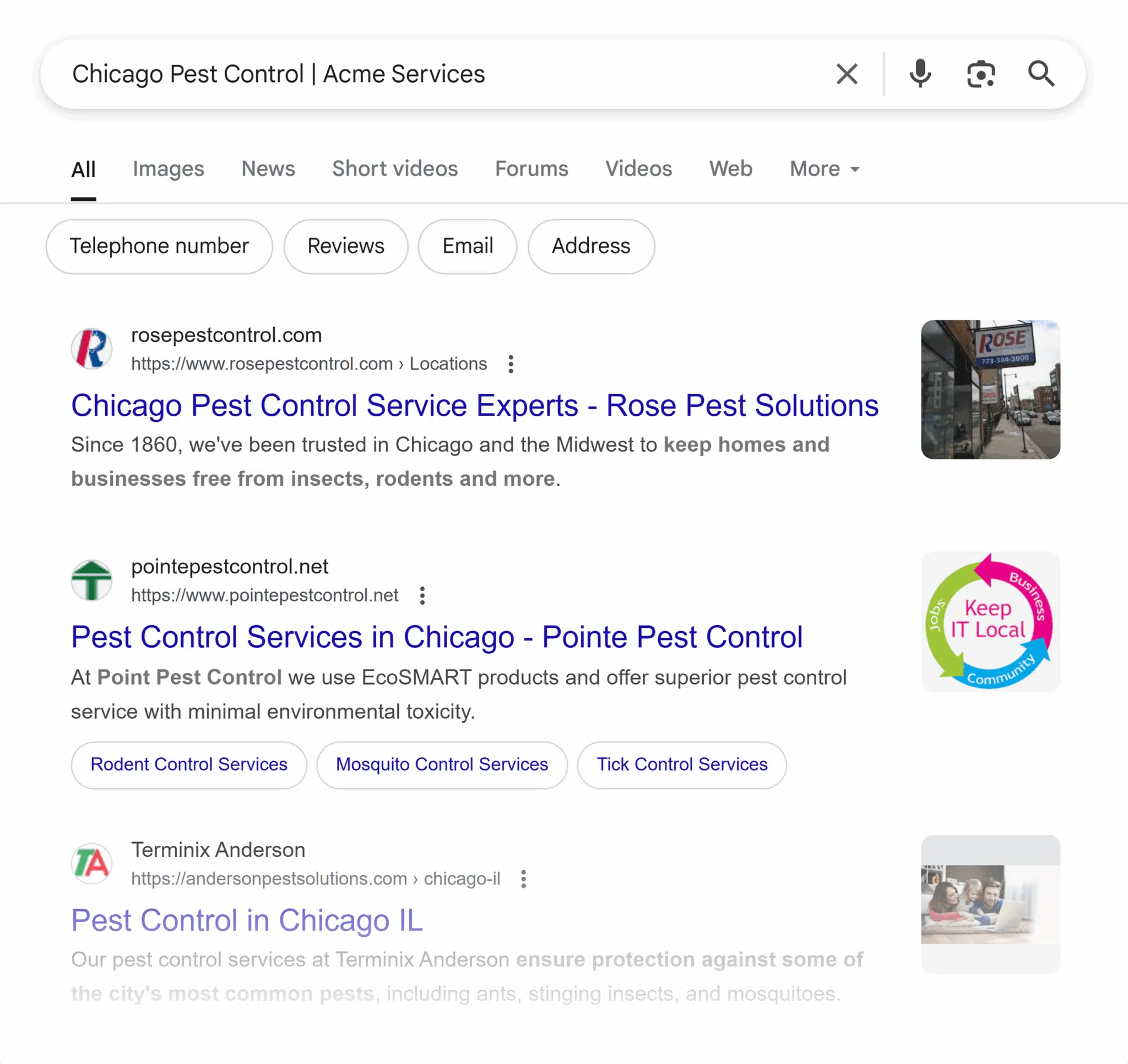
This small rule will make sure every location-specific service page is optimized for local relevance and is consistent with your brand’s messaging.
Guardrails for local content creation and brand voice
You can’t connect with local audiences if your content doesn’t speak their language and satisfy what they’re looking for on your webpage.
For example, Maria.B. is a global fashion brand that serves customers across the US, UK, Canada, UAE, and Pakistan. But when a user searches for “Maria B Pakistan” and clicks through to their site, they’re redirected to the UAE location page.
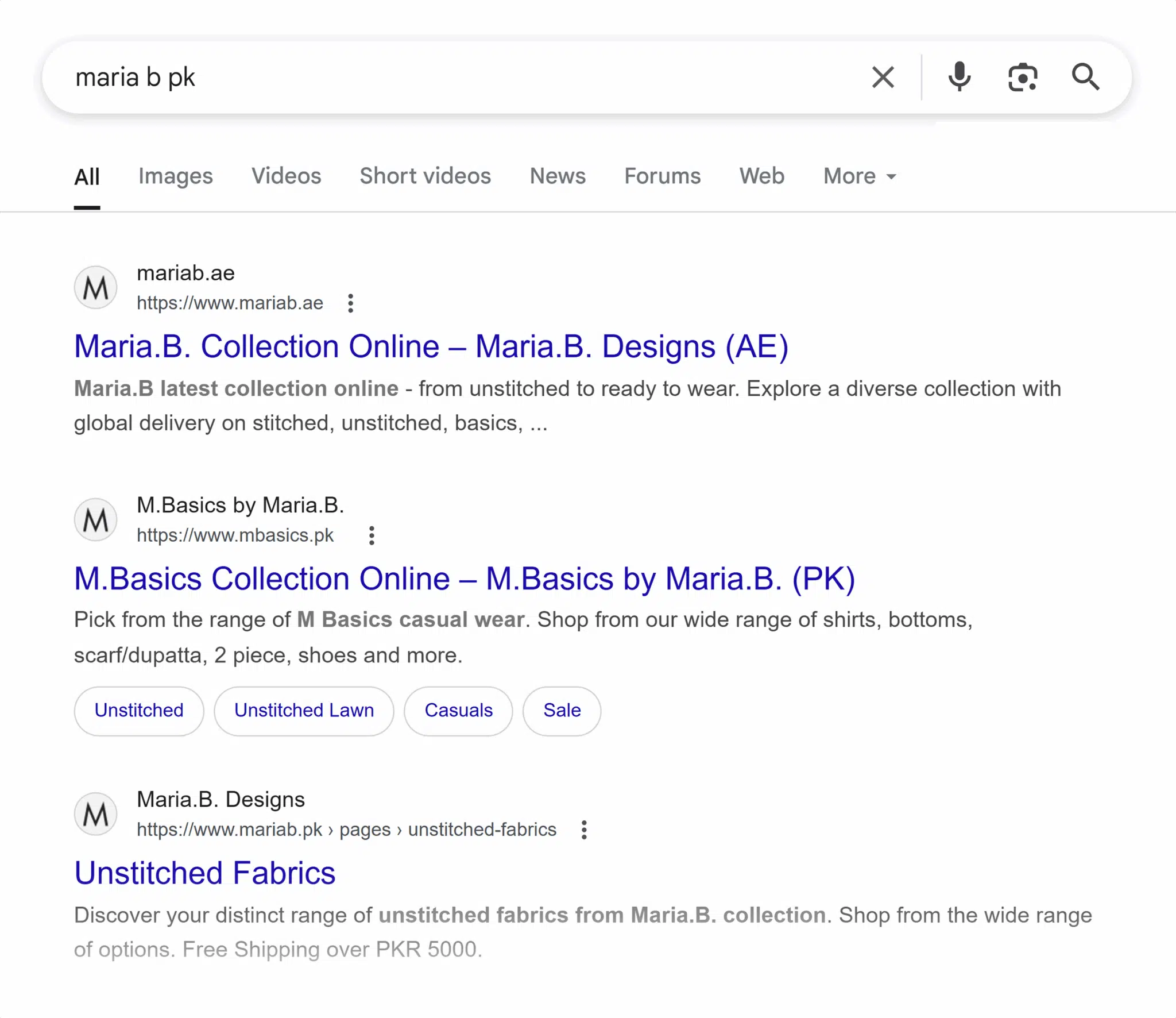
There, the prices are shown in USD with no option to switch to PKR. That’s confusing for a local shopper. Because if the brand claims they deliver to Pakistan, how is a local user supposed to know how much a dress costs in PKR?

And when something like this feels “off,” a user is much more likely to leave the website instead of shopping because the user’s trust in the brand has been broken.
That’s why local content needs guardrails. Guardrails outline how your local teams can tailor content and messaging to multiple locations.
To set these guardrails, your governance policy should outline:
- Rules around handling sales and pricing for each location
- Examples of brand voice in local messaging (how to sound local, not off-brand)
- Language dos and don’ts for region-specific copy
- Approved assets like logos, photography, and local CTAs
Approval workflows for publishing
When different teams are working across multiple locations on SEO, it’s easy for updates to go live without proper checks. To avoid this, your SEO governance policy should have a clear approval process, so that every team member knows who’s responsible for making changes and who reviews them.
Here’s what that can look like in practice:

For example, your teams can use a project management software like Trello or Monday.com to manage content approval workflows. Here’s an example of what it looks like for us here at MarTech:
- A writer submits a task, which moves to “Draft Review” for the editor to check for accuracy.
- From there, it goes to “Final Review,” where the senior editor approves it.
- Once approved, it moves to the “Ready for Publishing” tab.
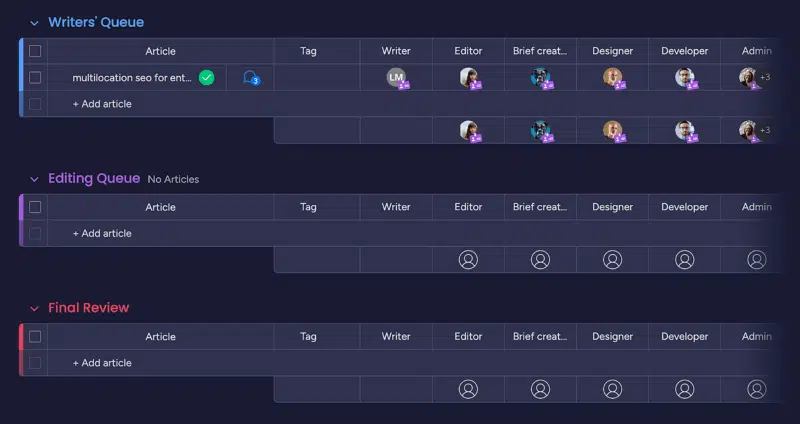
This way, nothing without the last (and final) review.
Maintaining data cleanliness
Poor data quality means having outdated, inconsistent, or incomplete information across your local locations.
Imagine a team member at Zerox Shoe Co. updates the Chicago store’s closing time to 8 PM in the CMS but forgets to update it on GBP, which still says 9 PM.
A customer sees the old time, drives over, and finds the store closed. They’re frustrated. Worse, if they leave a bad review, then Google would start doubting the accuracy of your listings.
Why does this happen?
Because updates are made in silos: CMS is updated, but GBP isn’t, so the data is inconsistent.
The best way to avoid these errors is to sync your CMS directly with listing management tools. You can do this using the Listing Management tool, PinMeTo, or Yext. That way, any update you make automatically reflects across your listings, everywhere.
Let’s see how to do this using the Listing Management tool:
- Subscribe to the Local Pro Plan to get the Listing Management API.
- Contact their team to set up locations in bulk.
- Once that’s set up, use the API to connect your tool of choice (CMS or CRM)
Training and documentation
It’s easy for processes to fall apart when everyone’s working off scattered notes or relying on their memory. That’s why you need a central knowledge hub. It could be a Notion board or a shared Google Document where all your SEO policies and workflows are documented.
Here’s what that can look like:
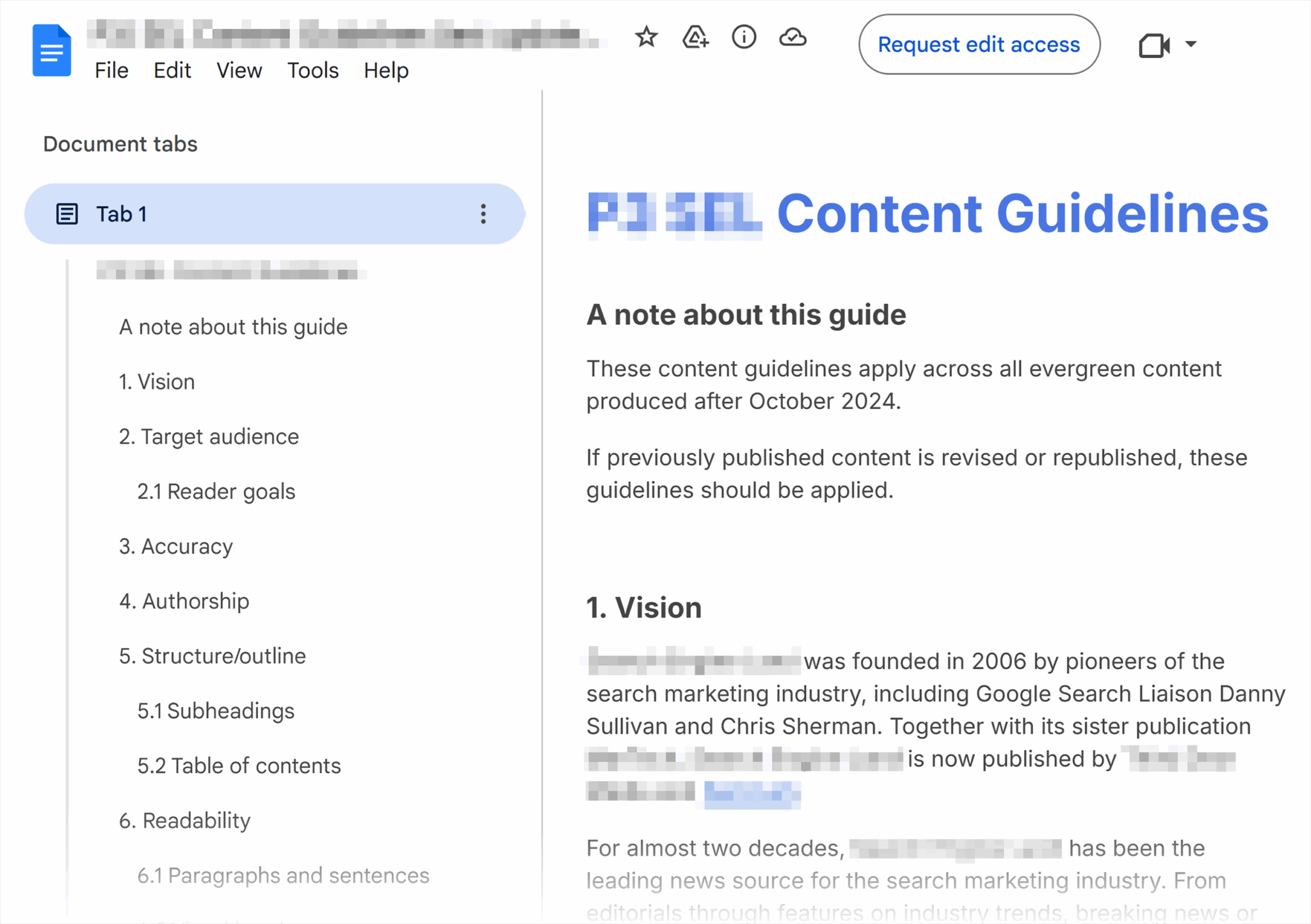
But what if your team still doesn’t understand all aspects of multi-location SEO?
Then, you can create video walkthroughs for main processes, like how to optimize your GBP. That way, new team members can ramp up quickly, and experienced ones can get quick refreshers whenever needed.
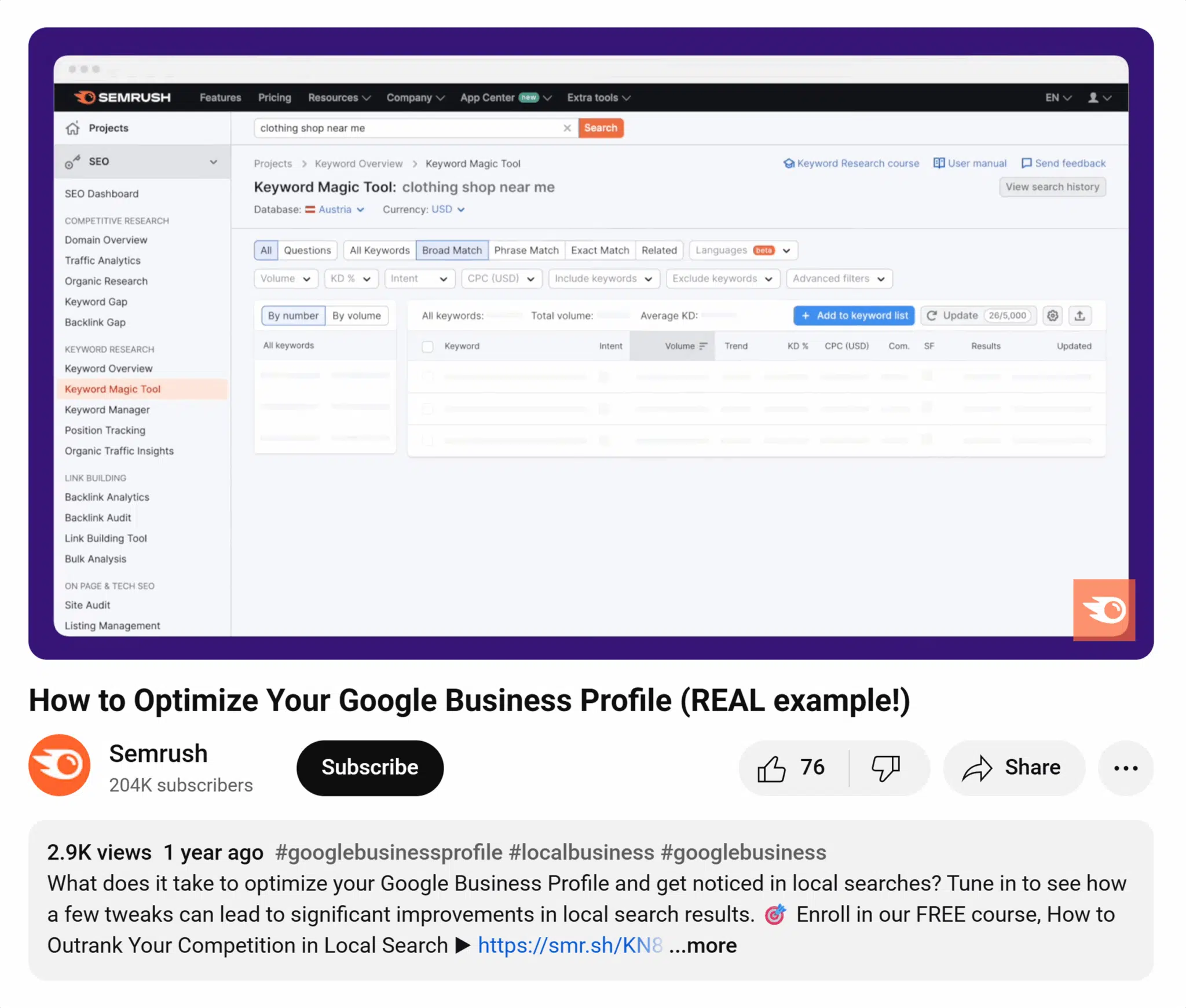
This kind of documentation and training ensures your whole team moves in the same direction.
Ready to scale your enterprise SEO across multiple locations?
Here’s how you can do it:
Use a local SEO tool like Semrush Local. It’s an all-in-one SEO suite that can track local search performance and push updates to Google Business Profiles in bulk. Its dashboard even flags issues so you can fix them immediately.
Still not sure why you should use an SEO tool to scale? Check out our guide on how SEO tools can help you get found on search engines.
New on MarTech